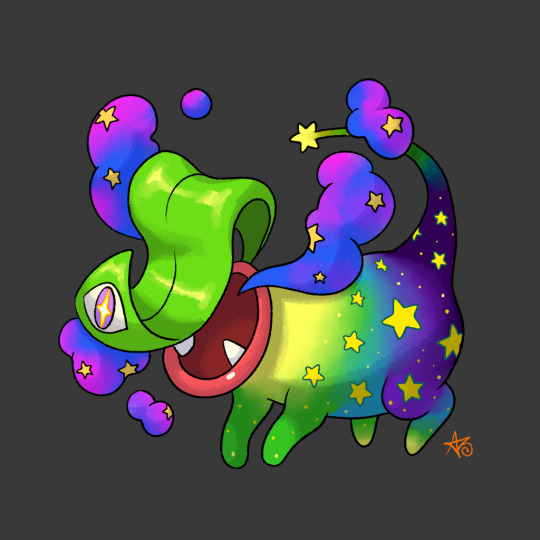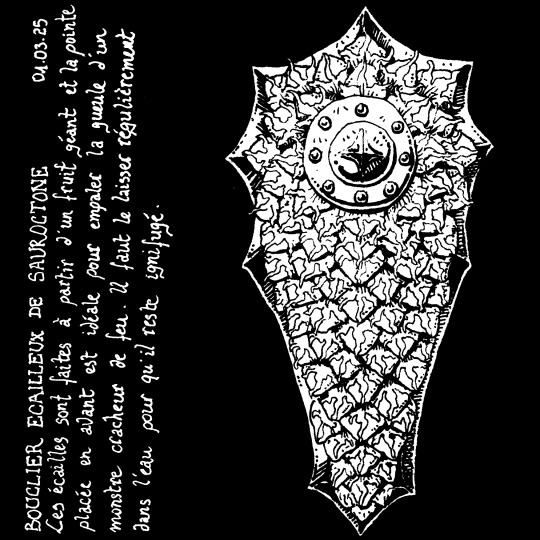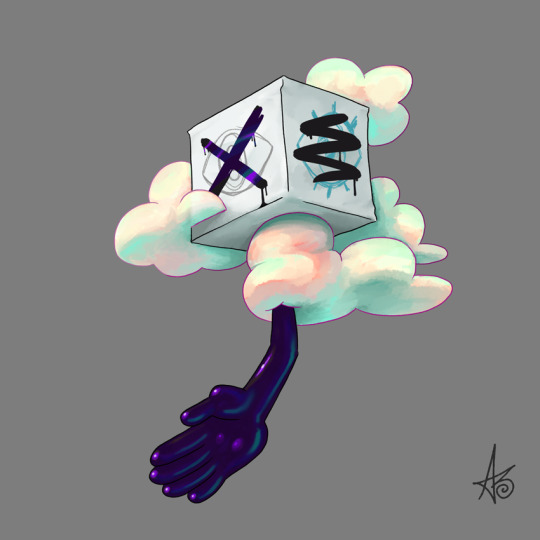Lewis 28. I Reblog art, animals, speculative evolution and occasionally post something I make in SPORE.
Don't wanna be here? Send us removal request.
Text

Icon for Quematrice; The Flame Tail Wyvern! 10/22
Getting through them now...
103 notes
·
View notes
Text

Ko-fi Dooble: "The Dream Eater Nepenthes"
Consider supporting me on ko-fi and get your own monster dooble!
109 notes
·
View notes
Text

Some claim that Relicanth live for thousands of years at the bottom of the ocean. This likely isn't true, but so far no one has managed to prove otherwise. The Relicanth know, of course, but they don't care to share.
110 notes
·
View notes
Text

a doodle of my headworld creature. the humble worm. you are simply unprepared for how much I’ll be posting about these things… eventually
609 notes
·
View notes
Text

🪙
Context- Southbound is an **artificial** speculative evolution project centering primarily around the speculative biology and evolution of machines, often with a focus on aircraft. Unless specifically stated otherwise, instalments take place somewhere on the surface of the tidally-locked planet, Xoturanseria (Anser).
Specific Context-
Page 1- Life cycle
Egg- Eggs are most commonly laid in groups of 3-5, deposited in a honeycomb structure most commonly placed along the inside of a rock depression or shallow hole where the eggs can be readily rehydrated. In courting season, mature Johnny Darters will often visit the nesting sites of others to contribute their own genetic material into the eggs.
Instar I Kettlet- Johnny Darter kettlets are born much in the same way kittens on Earth are born, blind and deaf. They hatch covered in a thin, fuzz-like layer of pycnofibers. The places on the body not covered in pycnofibers are translucent, due to the machine's still very thin dermal layer. They also only possess six limbs, rather than the eight limbs present in adults.
Instar II Mite- Darter mites are mall, vaguely griffin-like machines which demonstrate dorsal wing growth, though still no proper pin feathers. It is around this stage that the mite will begin to move actively within its cell, and may attempt to crawl out. Diligent darter parents will often be seen taking mites that have fallen out of their cells, and putting them back where they belong, often with a disgruntled hiss.
Instar III Whelp- Whelps are bizarre little critters which have finally matured out of comb containment. It is around this point that their elongated beaks are finally gaining the receptors of mature specimens, allowing them to effectively "see" the world for the first time. Development of pin feathers on the wings and tail begins to occur.
Instar IV Subadult- Although the label seems absurd, subadult darters truly *are* subadults. It is at this point where their pin feather development seems to really take off, replacing the pycnofibers with feathers nearly identical in composition to those seen in real Terran birds. What were once the hindlimbs of the young ornithopter have rotated backwards permanently to form the basis of the outer tail. The telson sticks out slightly where feathers will soon grow out to cover it. The forelimbs have since moved further down the body to replace the reconstituted hindlimbs.
Instar V Bastard- The bastard is, for all intents and purposes, a functional adult, however, it is not the *imago* form of the species. Rather, it is the odd transitional period between the scraggly subadult and the intimidating imago phase the Johnny Darter is so iconic for. Bastards are kicked out of the roost once they begin exhibiting issues pertaining to teething as the sparking fangs grow in.
Imago- The final form of a natural Johnny Darter, imagines are easily identified by the overly *skeletal* appearance of the head and neck, the result of the skin being burned off. Imago Johnny Darters possess fangs in their throats used to spark magnesium, allowing them to effectively breathe fire. If these fangs are surgically removed, the darter will retain facial skin, and looks quite similar to merely a larger bastard. This practice is occasionally done in aviaculture to make for a more "visually-appealing" machine. Although the lights along the machine's neck might resemble eyes, in function they act similar to dazzlers, like in other dokuhaku species.

Page 2-
Johnny Darter
(Anhaerja marik)
The Johnny Darter is a large sojourner ornithopter found exclusively on the island of Ti Marik in the Xtoltazan Archipelago. It is unique in the fact that its entire head and neck lack skin in adulthood. This is due to the fact that new skin that grows is quickly burned back when the machine utilizes its ability to breathe a concentrated, magnesium-based fire from its mouth, or the holes lining its nape plates.
Despite appearing to be eyes, the red lights lining the machinery are actually cameras that have been modified into dazzlers- a trait common in the dokuhakus. Unlike most other dokuhakus, Johnny Darters are surprisingly adept at walking. They are also capable of flight, another trait rarely seen in the lineage.
These machines are never recommended to first-time proctors primarily due to their unpredictable behavior. Although incapable of digesting flesh, darters have been known to drink blood from carbon-based lifeforms. This dietary supplement makes for a rather unique kind of gladeston only ever observed in this species. The high value of darter gladeston has encouraged proctors to provide live animals such as goats for "feeding". In the wild, 80% of a Johnny Darter's diet consists of fish, with a particular preference for keeljaws.

Page 3-
Kaliji Blood Darter
(Anhaerja marik domesticus)
The Kaliji Blood Darter is a flightless civil dokuhaku resulting from a selective hybridization between a Johnny Darter and an Akanoko. Compared to their nominate parents, blood darters are quite small, only being around the same height as a wild turkey.
Their sole purpose in aviaculture is to be farmed for gladeston. Despite being far smaller and lighter than a Johnny Darter, the Kaliji produces a far larger yield of darter gladeston than its progenitor, for far less applied resources.
Darters are allowed to graze passively on oats and pellets typically consisting of byproducts from machine processing, supplemented with weekly blood meals. Some farming operations allow for live-feeding, whereas others opt for the far less risky method of pouring blood into the existing feed mixture.
Machines retired from blood farms often are auctioned off to prospective buyers looking to get an ornithopter. They are commonly advertised as being "subadult" Johnny Darters, despite this being a blatant lie. In the farms these ornithopters are raised in, any machine that escapes containment is put under a "shoot on sight" order. The same genes meant to increase gladeston production also happen to contribute quite significantly to aggression and irritability.
Inexperienced keepers often die having had the experience of being kicked to the ground before having their blood and lymph siphoned out of their bodies.
10 notes
·
View notes
Text

Chondestes grammacus | Zonotrichia querula | Zonotrichia albicollis | Zonotrichia leucophrys | Peucaea aestivalis | Passerella iliaca
Plate XXIV | Die Nordamerikanische Vogelwelt (1891)
242 notes
·
View notes
Text

Dragonslayer’s Scaly Shield Value ●●●○○ ; Size ●●○○○ The scales are made from a giant fruit, and the pointed tip is ideal for impaling the mouth of a fire-breathing monster. It must be regularly soaked in water to keep it fireproof.
21 notes
·
View notes
Text

Ko-fi Dooble: "Balii - God of Ink, Writing Blocks, and Art Blocks"
Consider supporting me on ko-fi and get your own monster dooble!
53 notes
·
View notes
Text

ʻIʻiwi
Drepanis coccinea Hakalau Forest NWR Mauna Kea, Hawaiʻi
4K notes
·
View notes
Photo

Bari ‘The Legend Of Zelda: Ocarina Of Time’ Nintendo 64
117 notes
·
View notes
Text

Crimson Topaz for a $15 Ko-fi supporter
Crimson Topaz (Topaza pella) hummingbirds construct deep bowl-shaped nests out of gathered Bombax seeds and spiderwebs. They lay a clutch consisting of 2 elongated white eggs. (x, x)
344 notes
·
View notes





